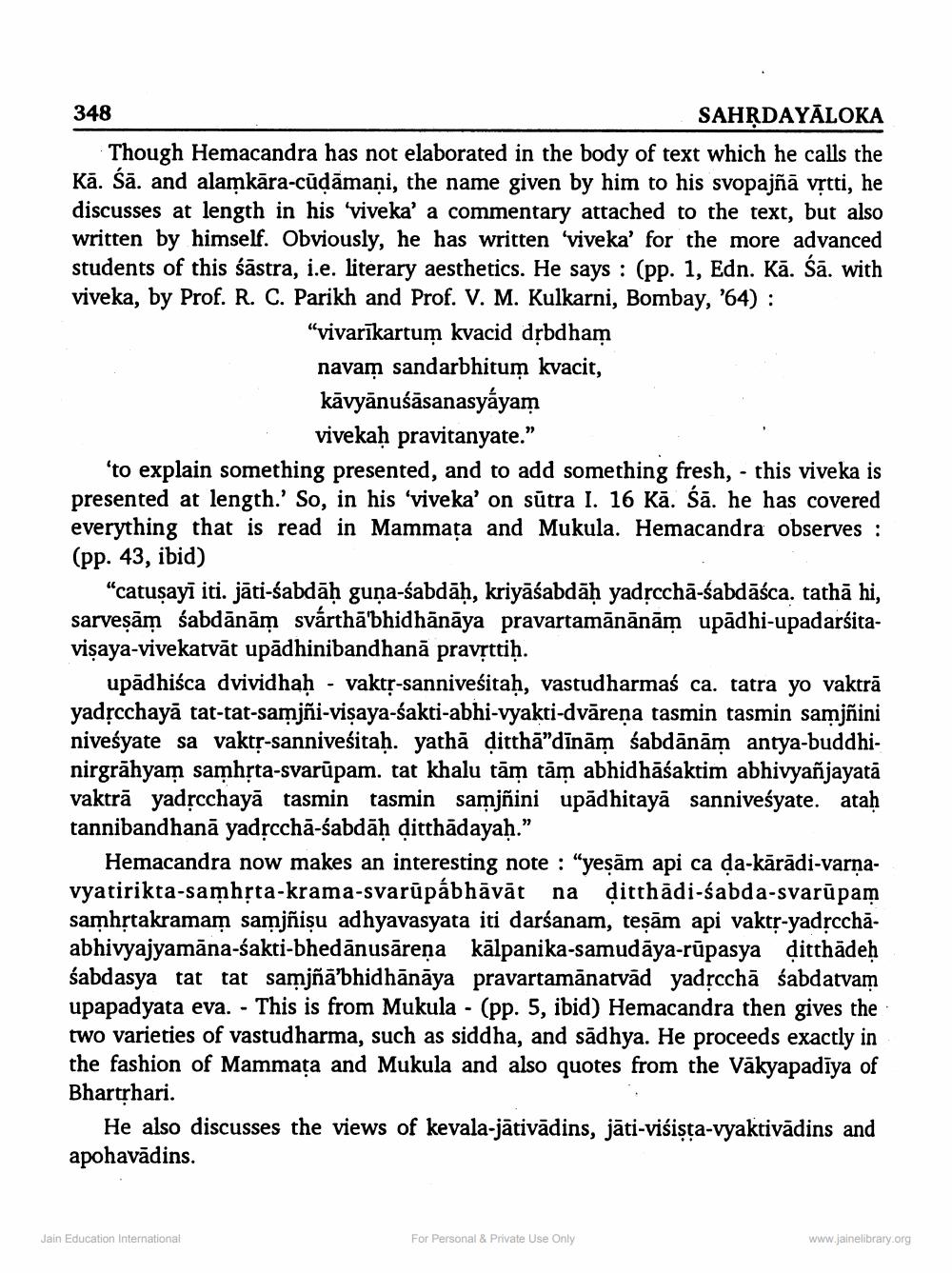________________
348
SAHRDAYĀLOKA Though Hemacandra has not elaborated in the body of text which he calls the Kā. Šā. and alamkāra-cūdāmani, the name given by him to his svopajñā vịtti, he discusses at length in his 'viveka' a commentary attached to the text, but also written by himself. Obviously, he has written 'viveka' for the more advanced students of this śāstra, i.e. literary aesthetics. He says : (pp. 1, Edn. Kā. Sā. with viveka, by Prof. R. C. Parikh and Prof. V. M. Kulkarni, Bombay, '64) :
"vivarīkartum kvacid dřbdham navam sandarbhitum kvacit, kávyānušāsanasyayam
vivekaḥ pravitanyate." 'to explain something presented, and to add something fresh, - this viveka is presented at length.' So, in his 'viveka' on sūtra I. 16 Kā. Sā. he has covered everything that is read in Mammata and Mukula. Hemacandra observes : (pp. 43, ibid)
"catuṣayı iti. jāti-śabdāḥ guņa-śabdāḥ, kriyāśabdāḥ yadịccha-sabdāśca. tathā hi, sarvesām śabdānām svárthā'bhidhānāya pravartamānānām upādhi-upadarśitavișaya-vivekatvāt upādhinibandhanā pravsttiḥ.
upādhiśca dvividhah - vaktr-sannivesitah, vastudharmaś ca. tatra yo vaktrā yadscchayā tat-tat-samjñi-visaya-sakti-abhi-vyakti-dvāreņa tasmin tasmin samjñini niveśyate sa vaktr-sannivesitaḥ. yathā ditthā"dīnām sabdānām antya-buddhinirgrāhyam samhsta-svarūpam. tat khalu tām tām abhidhāśaktim abhivyañjayatā vaktrā yadrcchayā tasmin tasmin samjñini upādhitayā sanniveśyate. ataḥ tannibandhanā yadịcchā-sabdāḥ ditthādayah.”
Hemacandra now makes an interesting note : "yeşām api ca da-kārādi-varnavyatirikta-samhịta-krama-svarūpábhāvāt na ditthādi-sabda-svarūpam samhịtakramam samjñișu adhyavasyata iti darśanam, teşām api vaktr-yadrcchāabhivyajyamāna-sakti-bhedānusāreņa kālpanika-samudāya-rūpasya qitthādeḥ śabdasya tattat samjñā’bhidhānāya pravartamānatvād yadṛcchāśabdarvam upapadyata eva. - This is from Mukula - (pp. 5, ibid) Hemacandra then gives the two varieties of vastudharma, such as siddha, and sādhya. He proceeds exactly in the fashion of Mammața and Mukula and also quotes from the Vākyapadīya of Bhartặhari.
He also discusses the views of kevala-jātivādins, jāti-visista-vyaktivādins and apohavādins.
Jain Education International
For Personal & Private Use Only
www.jainelibrary.org




